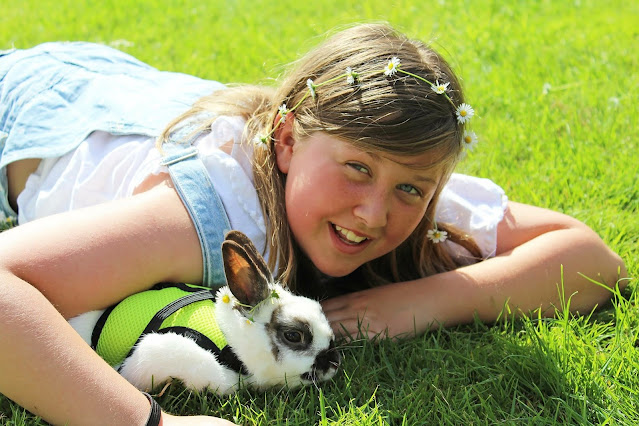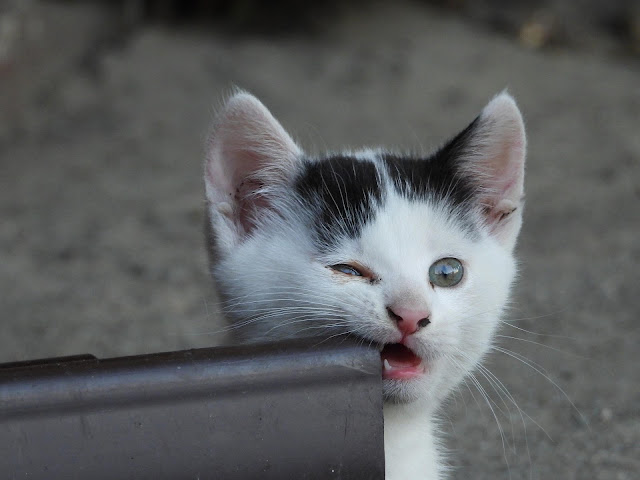Hares are dynamic and lively creatures that are additionally exceptionally friendly. They will frame a nearby bond with different hares and even with individuals. However long you know what's in store from pet hares, they can possibly be magnificent pets. The ideal proprietor for a pet bunny is an individual or family with the existence to commit to a functioning pet that appreciates snuggling and playing and requires a moderate measure of upkeep. Bunnies come in various varieties that reach apparently, including lionhead, small hack, little rex, rex, cut, Dutch, English spot, and hotot.
Bunny Behavior and Temperament
Bunnies are social animals. What's more, with delicate taking care of, they are for the most part very manageable, fun loving, and engaging to watch. Many might figure out how to answer their name and come when called.
Bunnies frequently structure close bonds with their proprietors and get a kick out of the chance to associate with them. A few bunnies are OK with being gotten. However, more frequently they favor their feet on the ground and appreciate snuggling up close to their proprietors for petting. They don't will generally nibble, however some could scratch in the event that they feel they're inappropriately dealt with. Consequently, pet hares ordinarily are certainly not a decent counterpart for youngsters who don't grasp delicate taking care of.
It is ideal to keep more than one bunny to meet their social necessities. Individuals from the other gender can be held together for however long they are fixed and fixed. In addition, a few bunnies can coexist with other family pets, including polite canines and felines. In any case, they ought to never be around different creatures that could see them as prey.
Hares are for the most part calm pets, and their consideration is genuinely direct with everyday feedings and standard cleanings. Everyday work-out beyond their enclosure likewise is a need. What's more, they need to bite. So loads of safe bite toys ought to be given, and any spaces where the hare is permitted to wander should be cautiously bunny sealed. A bunny that is denied of toys and socialization frequently becomes damaging.
Size Information
Hare breeds range broadly in size, extending around 8 to 20 inches long. There are little varieties that just several pounds, also as enormous varieties that can be 20 pounds or more.
Lodging
Hares are prey creatures, and that implies lodging your bunny outside is for the most part just plain dumb; keep your bunny nook inside.
While not being straightforwardly managed, your hare ought to be kept in a walled in area that is something like 2 feet by 3 feet for one medium-size bunny. Various hares housed together need more space. The level of the nook ought to be more noteworthy than the level of your bunny when it completely extends up on its rear legs. Since bunnies have delicate feet, keep away from wire-base enclosures; a superior decision is a plastic-base canine case.
Inside the nook, give your bunny:
- A lot of toys, including bite toys
- A rack onto which your hare can bounce to keep up with leg strength
- Fired food and water dishes
- A litter box
With every one of the things in the fenced in area, ensure there's still sufficient space for your bunny to completely loosen up with its back legs expanded.
Many pet hares are permitted to wander around the house when their proprietors are near. In the event that you decide to permit this, be extremely mindful so as to bunny resistant your home. Hares love to bite, and hazardous electrical ropes are at the perfect level for them to find and crunch on.
In the event that you'd prefer not to give your hare run of the house, you can give it an activity pen. Pens intended for pups are great. They give space to move without providing your rabbit with the choice of investigating possibly perilous spaces. Numerous proprietors even use practice pens as their bunny's essential nook.
Explicit Substrate Needs
Notwithstanding what kind of fenced in area you decide for your hare, ensure the floor is nonslip. A few proprietors put launderable covering on the nook floor to give the hare some pad. You likewise can put down a straw for your hare to make a comfortable home. Use color free paper litter in the litter box; never use amassing litter. Plan to clean the litter box basically every other day, and wipe down the entire walled in area with gentle cleanser and water week after week.
What Do Rabbits Eat and Drink?
Hares are herbivores, and their everyday eating routine ought to comprise generally of feed. Feed a limitless measure of grass roughage every day, for example, timothy, oat roughage, or plantation grass; keep away from hay roughage. You can just heap the roughage in the nook, or put it in an extraordinary feeder called a container. Simply ensure there's in every case some accessible.
Supplement the feed with various green verdant vegetables. Great decisions incorporate lettuces (with the exception of ice sheet), spices, watercress, carrot tops, cucumbers, and fledglings. Give a more restricted supply of different vegetables and natural products. Check with your vet on the amount to take care of and to be certain all things you offer are bunny safe. You can offer new food sources on more than one occasion per day, essentially putting them in the fenced in area close to your hare. Eliminate any uneaten new food following a couple of hours to forestall waste.
You likewise can offer a restricted measure of business bunny pellets. Nonetheless, overloading pellets can cause stomach related issues and obesity.4 So make certain to examine the taking care of sum with your vet. Place a day of pellets in a ceramic bowl. Dispose of any extra pellets prior to taking care of the following day's piece.
At last, hares generally ought to approach new water. Utilize either a ceramic dish or water bottle connected to the side of the nook (ensure your bunny knows how to drink from the container), invigorating the water day to day.
Normal Health Problems
Bunnies are inclined to specific clinical issues, for example,
- Stomach related issues, including blockages and loose bowels
- Eye issues, like corneal ulcers
- Respiratory contaminations
- Skin issues, like parasites and fleas
A few bunnies likewise could encounter congested teeth. Hare teeth persistently develop and should be worn out by means of their eating regimen and bite toys. Congested teeth can make it challenging for a bunny to eat and drink and normally should be managed by a vet.
Preparing Your Rabbit
Litter Training
Most bunnies take well to litter box preparing, as hares are genuinely perfect creatures that like to pick spots to be their latrine. Place a litter box that your bunny can without much of a stretch bounce all through inside the hare's nook where it's now been easing itself. Likewise ensure your bunny generally approaches a container when it's external its nook. It's ideal to restrict its out-of-confine region, (for example, to a doggy play pen) until the hare has figured out how to utilize a litter box. Like that, it shouldn't at any point be a long way from a container when it needs to ease itself.
Other than the litter, put a modest bunch of roughage in the crate, which ought to captivate your bunny to go in. Supplant the roughage day to day to keep it sterile, and supplant the litter each several days. On the off chance that the case turns out to be too grimy, the hare is logical not to need to utilize it. Besides, hares that aren't fixed or fixed are bound to let themselves outside free from the litter box as a method for denoting their region.
Work out
Getting a few hours of activity each day is fundamental for keep a hare blissful and to forestall medical problems, like weight. Let your hare out of its nook however much as could reasonably be expected to permit it to wander in a protected region, for however long you're ready to manage. At least four hours beyond the nook each day is great. To support movement, offer toys, for example, a passage for investigation or a treat ball.
Prepping
Hares truly do prepare themselves, however brushing assists with eliminating free fur and forestall hairballs. Brush short-hair hares generally one time each week. Long-hair hares frequently need brushing everyday to forestall tangles and mats.
Showers are by and large excessive, however you could have to detect clean a messy piece of your hare's jacket by tenderly scouring it with a moist fabric.
Most bunnies additionally need nail manages, as they don't normally wear out their nails sufficient in their indoor climate. Your vet can tell you the best way to manage nails at home appropriately.
Upkeep Costs
Bunnies might be little, yet they are generally costly creatures. Consistently, your essential costs will be for food and litter. Hope to spend somewhere in the range of $40 and $60 by and large, contingent upon the number of hares you that have and which assortments you pick. Besides, you'll have to supplant worn toys — particularly bite toys — consistently at an expense of around $10 to $20. At long last, remember to spending plan for routine veterinary tests and crises.
Stars and Cons of Keeping a Rabbit as a Pet
Hares hush up pets that don't take up a lot of room. They likewise can be very friendly, energetic, and drew in with their proprietors. In any case, their upkeep is generally costly. What's more, they need a ton of communication, which frequently implies keeping a subsequent bunny.
Comparable Exotic Pets to the Rabbit
Assuming you're keen on pet hares, look at these other outlandish pets:
- Chinchilla
- Guinea pig
- Rodent
Buying or Adopting Your Rabbit
You can track down hares at pet shops, however the shops frequently probably won't have the option to give you satisfactory data about their bunnies' wellbeing and history. Going through a legitimate reproducer or salvage organization is better. Adoptable bunnies are not difficult to track down, as certain individuals will quite often misjudge the creature's consideration needs, cost, and life expectancy. Hope to pay somewhere in the range of $20 and $100 by and large, however this can shift in view of such factors as the hare's age and breed.
Proliferation/Breeding
Neighborhood extraordinary creature veterinarians could possibly suggest a decent raiser or salvage association for you. The fundamental advantage of a raiser is you'll probably have a more extensive choice of more youthful creatures and more uncommon varieties. Nonetheless, don't discount more established salvage hares. You'll have the option to get a capable of a more established hare's character immediately, and they're many times currently tame around individuals and even litter prepared.















